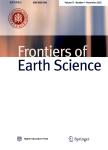Impact of thermal time shift on wheat phenology and yield under warming climate in the Huang-Huai-Hai Plain, China
Impact of thermal time shift on wheat phenology and yield under warming climate in the Huang-Huai-Hai Plain, China作者机构:Institute of Geographical Sciences Hebei Academy of Sciences Shijiazhuang 050011 China Key Laboratory for Agricultural Water Resources Hebei Key Laboratory for Agricultural Water-Saving Center for Agricultural Resource Research Institute of Genetics and Development Biology Chinese Academy of Sciences Shijiazhnang 050021 China Department of Agricultural Engineering School of Technology Njala University Freetown Sierra Leone Juncao Research Institute Fujian Agriculture and Forestry University Fuzhou 350002 China
出 版 物:《Frontiers of Earth Science》 (地球科学前沿(英文版))
年 卷 期:2017年第11卷第1期
页 面:148-155页
核心收录:
学科分类:07[理学] 09[农学] 0708[理学-地球物理学] 0706[理学-大气科学] 0901[农学-作物学] 0704[理学-天文学]
基 金:Acknowledgements This study is supported by the National Natural Science Foundation of China (Grant Nos. 41401104 and 41371002) Natural Science Foundation of Hebei Province China (D2015302017) China Postdoctoral Science Foundation funded project (2015M570167) and the Science and Technology Planning Project of Hebei Academy of Science (15101). We are grateful to the editors and anonymous reviewers for their insightful inputs at the review phase of this work.
主 题:adaptation thermal time shift crop phenology winter wheat warming climate
摘 要:Given climate change can potentially influence crop phenology and subsequent yield, an investigation of relevant adaptation measures could increase the understanding and mitigation of these responses in the future. In this study, field observations at 10 stations in the Huang- Huai-Hai Plain of China (HHHP) are used in combination with the Agricultural Production Systems Simulator (APSIM)-Wheat model to determine the effect of thermal time shift on the phenology and potential yield of wheat from 1981-2009. Warming climate speeds up winter wheat development and thereby decreases the duration of the wheat growth period. However, APSIM-Wheat model simulation suggests prolongation of the period from flowering to maturity (Gr) of winter wheat by 0.2-0.8 d·10yr^-1 as the number of days by which maturity advances, which is less than that by which flowering advances. Based on computed thermal time of the two critical growth phases of wheat, total thermal time from floral initiation to flowering (TT_floral_initiation) increasesd in seven out of the 10 investigated stations. Altematively, total thermal time from the start of grainfilling to maturity (TT_start grain_fill) increased in all investigated stations, except Laiyang. It is thus concluded that thermal time shift during the past three decades (1981- 2009) prolongs Gr by 0.2-3.0 d·10yr^-1 in the study area. This suggests that an increase in thermal time (TT) of the wheat growth period is critical for mitigating the effect of growth period reduction due to warming climatic condition. Furthermore, climate change reduces potential yield of winter wheat in 80% of the stations by 2.3-58.8 kg·yr^-1. However, thermal time shift (TTS) increases potential yield of winter wheat in most of the stations by 3.0-51.0 Received September 16, 2015; accepted January 24, 2016 kg·yr^-1. It is concluded that wheat cultivars with longer growth periods and higher thermal requirements could mitigate the negative effects of warming climate on crop production in the study area.



